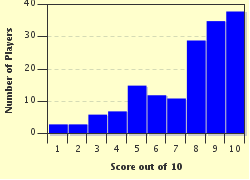Quiz Answer Key and Fun Facts
1. Baseball great Bert Blyleven won 287 games and struck out 3701 batters. That said, the first paragraph of almost any Blyleven biography will point out that he was known for his monster:
2. The screwball is perhaps the hardest pitch on a hurler's arm. It tends to shorten careers, and young pitchers are often advised to stay away from it. That said, several pitchers have taken up the challenge and contributed beautiful moments to the tapestry of the game. Which of these pitchers is included in this number?
3. Steve Carlton was one of the greatest pitchers of any era. He won four Cy Young awards, notched over 4000 strikeouts, and posted a lifetime record of 329-244. Though Carlton threw many pitches, he and most observers attribute his success mostly to one pitch, and for over 10 years his website featured a section on throwing it. Which pitch was this?
4. It is extremely rare for a pitcher to rely on one pitch, unless that pitch is the knuckleball. Since the knuckleball's delivery is so unique, pitchers avoid mixing it with other pitches, since a poorly delivered knuckleball is probably the most hittable pitch a Major League hitter will ever see. All that said, what career knuckleballer made a point of not throwing his signature pitch in his 300th win until facing the final batter?
5. "Don't try to strike everybody out. Strikeouts are boring! Besides that, they're fascist. Throw some ground balls, it's more democratic." This quote from 'Bull Durham' epitomized the philosophy of Tom Glavine. Glavine did get his share of strikeouts, but relied more on getting his outs from poorly-hit ground balls. What was Glavine's go-to pitch in his best seasons?
6. Elroy Face was one of the pioneers of the relief ace role, going to the All-Star Game six times and recording 17 straight relief wins in 1959. What (relatively) uncommon pitch was his bread and butter?
7. New York Yankees reliever Mariano Rivera has been one of the most dominating closers in the history of the game. A relatively late bloomer, Rivera settled into the late relief role in 1997 after having control problems with his four-seam fastball and spontaneously learning how to throw another pitch, relying on it almost exclusively afterwards. What career-saving pitch was this?
8. In 1920, the Major Leagues began to phase out the spitball, allowing only certain grandfathered pitchers to finish out their careers greasing the leather sphere. Various pitchers were able to work around this prohibition, however, some even making careers out of it. Which of these baseball men worked the pitch for 314 wins and a spot in the Hall of Fame?
9. Rip Sewell enjoyed a fine career, going 143-97, mostly for the Pittsburgh Pirates. Sewell's signature pitch was a slow, arcing curveball that was nearly impossible to hit well. What nonsensical name did the pitch go by?
10. By far, the most relied-upon pitch in the Major Leagues is the fastball, and many great pitchers made their livings throwing it the lion's share of the time. Most pitchers must mix in breaking balls and off-speed pitches, however, to keep elite hitters off balance. Which of these pitchers was least likely to do this, having an awe-inspiring reputation as an overpowering fireballer?
Source: Author
stuthehistoryguy
This quiz was reviewed by FunTrivia editor
Nightmare before going online.
Any errors found in FunTrivia content are routinely corrected through our feedback system.

